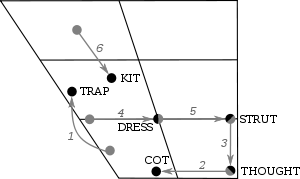Northern Cities Vowel Shift

The Northern Cities Vowel Shift (or simply Northern Cities Shift) is a chain shift affecting the sounds of certain vowels in the Inland Northern regional dialect of American English, found in the Great Lakes region. It is the defining feature of the Inland North dialect region, and elements of it are also found to a lesser degree in Upper Midwest American English and Western New England English.
Geography
The name of the shift comes from the region where it occurs, a broad swath of the United States along the Great Lakes, beginning some 50 miles (80 km) west of Albany and extending west through Utica, Syracuse, Rochester, Buffalo, Cleveland, Detroit, Flint, Chicago, Milwaukee, Madison, and north to Green Bay.
William Labov, a linguist at the University of Pennsylvania, believes that the trend may have started in the early 19th century during the construction of the Erie Canal. Migration of workers from the East Coast to the Great Lakes area brought together speakers of different varieties of English, a situation in which language change can be expected to proceed quickly.[1]
Phonetics



Raising and tensing of /æ/
The first sound change in the shift, which was identified in the Northern states as early as the 1960s by Fasold,[5] was the general raising, tensing, and lengthening of the "short a", that is, the vowel of trap: IPA /æ/. Inland Northern /æ/ comes to be articulated so that the tongue starts from a position that is higher and fronter than it used to be, and then often glides back toward the center of the mouth, thus producing a centering diphthong of the type [ɛə] or [eə] or at its most extreme [ɪə], which is the vowel heard in England in words like pier and beer. Thus cat and that as pronounced by a Rochesterian may sound like "kyet" and "thyet" to a visitor.
Fronting of /ɑ/
The raising of /æ/ leaves an empty space in low front position that allows /ɑ/ to be fronted in the direction of [a]. /ɑ/ was the vowel in Great Lakes residents' pronunciation of both cot and father, often called "short o" (or "broad a"). Therefore, /ɑ/ comes to be pronounced farther forward in the mouth, similar to the vowel of car as pronounced in Boston; for some advanced speakers, it may be close or even identical to [æ]—that is, the vowel of cat for speakers without the shift.
Lowering of /ɔ/
The fronting of /ɑ/ leaves a blank space in northern American English speakers' pronunciation that is filled by lowering /ɔ/ (the "aw" vowel, as in saw), which comes to be pronounced with the tongue in a lower position, closer to [ɑ]. As a result, for example, people affected by the shift may pronounce stalk the way speakers without the shift say stock, with both using the vowel [ɑ~ä]. This is true specifically in the northern U.S. dialect known as "Upper Midwest" and is known as the cot–caught merger; however, this phenomenon does not occur in the neighboring northern dialect labelled the "Inland North" because this dialect's NCVS speakers also round [ɑ] as [ɒ], thus preserving the distinction between words like cot and caught or stock and stalk. The NCVS causes both Upper Midwest and Inland North speakers to front the original /ɑ/ phoneme into the vicinity of [a~ä], thus allowing an overlap of the cot–caught vowels for Upper Midwest, but not Inland North, speakers.
Backing and lowering of /ɛ/
The first stage, æ-tensing, resulted in a vowel that sounded confusingly like [ɛ], similar to the "short e" in bet. Northern /ɛ/ moves in the direction of [ɐ], the near-open central vowel. As the vowel [ɐ] is pronounced with the tongue farther back and lower in the mouth than in the sound [ɛ], this change is called "backing and lowering."
Backing of /ʌ/
The next change is the movement of /ʌ/ toward [ɔ]. /ʌ/ is the "short u" vowel, as in bus or cut. People with the shift pronounce bus so that it sounds more like boss to people without the shift.
Lowering and backing of /ɪ/
The final change is lowering and backing of /ɪ/, the "short i" vowel, as in bit. This makes it sound more like /ɛ/, although the sounds remain distinct.
Prevalence
Like most chain shifts, the Northern Cities Vowel Shift is not complete in all areas at the same time: some but not all aspects of the shift can be found further afield. For example, the backing of /ɛ/ is found as far south as Central Illinois and as far west as Cedar Rapids, Iowa, and the diphthongization of /æ/ before most consonants is found in parts of Minnesota, such as St. James, Minneapolis–Saint Paul, and Brainerd. Accents in which /ʌ/ is more retracted than /ɑ/ are encountered as far east as Providence, Rhode Island, and as far north as Bemidji, Minnesota, and as far west as Aberdeen, South Dakota.[6] The shift is in progress throughout the Great Lakes cities; thus some speakers might have, for instance, the first two stages only, but none have only the last stage.
The shift is mainly found in European American speakers. Speakers of African American Vernacular English show little to no evidence of adopting the shift. It has also not been adopted by Canadian speakers, even though several Canadian communities (such as Windsor and St. Catharines, Ontario) are immediately adjacent to major Northern Cities Shift–using cities.
People displaying aspects of NCVS
- Drew Carey (Cleveland, Ohio)
- John Goodman (St. Louis, Missouri)
- Jenna Marbles (Rochester, New York)
- Bruce Campbell (Royal Oak, Michigan)
- Tom Kenny (Syracuse, New York)
See also
Notes
- ↑ Haynie, Devon (April 10, 2007). "Where'd you learn to speak like thee-at?". Columbia News Service. Retrieved January 28, 2009.
- ↑ W. Labov, S. Ash and C. Boberg (1997). "A national map of the regional dialects of American English". Department of Linguistics, University of Pennsylvania. Retrieved October 28, 2012.
- ↑ Hillenbrand, James M. (2003). "American English: Southern Michigan" (PDF). Journal of the International Phonetic Association. 33 (1): 122. doi:10.1017/S0025100303001221.
- ↑ Mannell, Robert (August 1, 2009). "American English Monophthongs". Macquarie University – Department of Linguistics.
- ↑ Fasold 1969
- ↑ Labov et al. 204
References
- Boberg, Charles (2000). "Geolinguistic Diffusion and the U.S.-Canada Border". Language Variation and Change 12:1–24
- Dinkin, Aaron (2007) and William Labov (2007). "Bridging the Gap: Dialect Boundaries and Regional Allegiance in Upstate New York". Paper presented at Penn Linguistics Colloquium 31.
- Gordon, Matthew J. (2001). Small-town Values and Big-city Vowels: A Study of the Northern Cities Shift in Michigan. Durham, N.C.: Duke University Press. ISBN 0-8223-6478-6.
- Labov, William; Ash, Sharon; Boberg, Charles (2006). The Atlas of North American English. Berlin: Mouton-de Gruyter. ISBN 3-11-016746-8.
External links
- Northern Cities Shift
- A National Map of The Regional Dialects of American English
- PBS resource from the show "Do you Speak American?"
- Detroit Area Vowels (bottom part of page) Chart and sound files at Penelope Eckert's website
- NPR interview with Professor William Labov about the shift
- Sedivy, Julie (28 March 2012). "Votes and Vowels: A Changing Accent Shows How Language Parallels Politics". Discover. Retrieved 4-7-2013. Check date values in:
|access-date=(help)